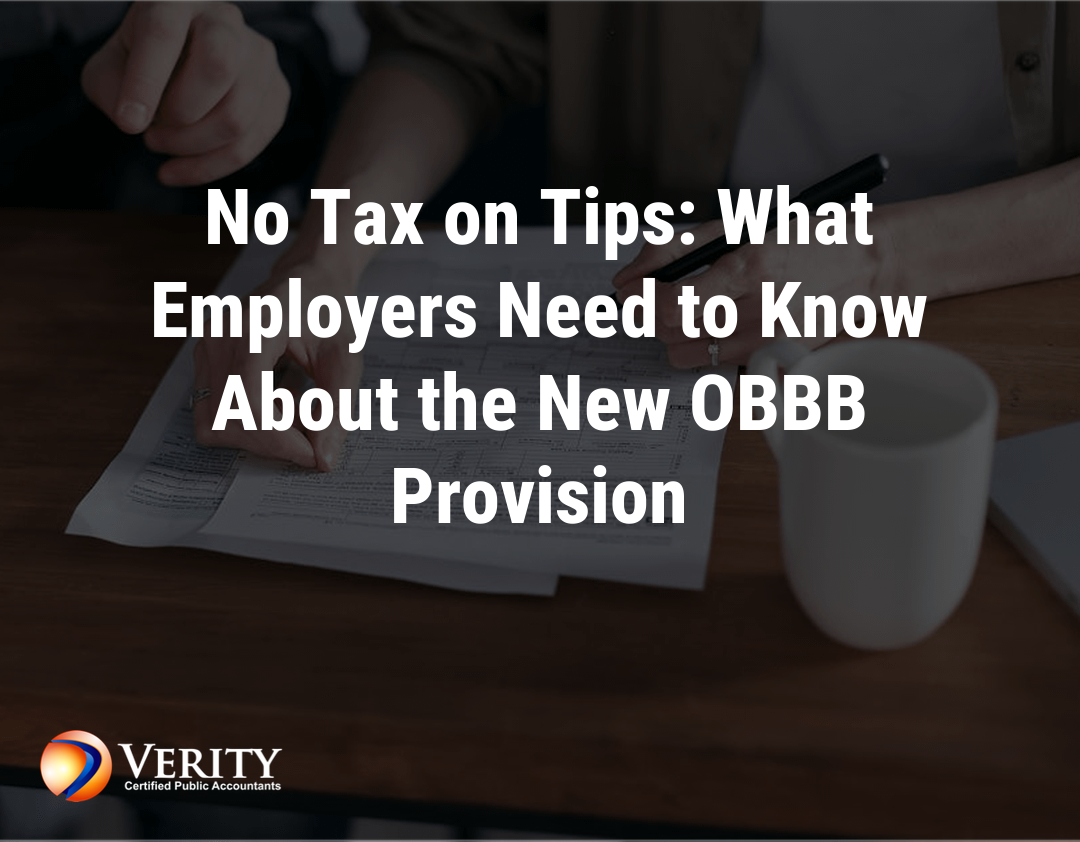This article was originally published by Aprio on October 30, 2025.
Summary: The One Big Beautiful Bil introduced a new provision that has major implications for employers across the restaurant, franchise, hospitality, and entertainment sectors. While the provision is designed to reward tipped employees, it also creates short-term compliance challenges for employers, who will be tasked with tracking, verifying, and reporting qualified tip income. Below, breaks down what employers need to know.
On the heels of the sweeping One Big Beautiful Bill (OBBB) that passed earlier this year, the so-called “No Tax on Tips” provision is one of the most talked-about changes affecting employers across the service industry.
Put simply, the provision allows certain tipped employees to exclude qualified tip income from their federal income tax return between tax years 2025 and 2028. With this provision, the government intends to provide financial relief for employees whose tips represent a significant share of their total earnings. Many of these employees work in the restaurant, hospitality, gaming, and entertainment sectors.
While the provision stands to benefit tipped employees, it simultaneously puts a new administrative burden on employers. Going forward, service businesses will be responsible for tracking and reporting their employees’ qualified tip income. At the same time, the IRS has provided guidance with respect to 2026 year-end reporting, and it has advised that no form changes will be made for 2025.
So, how exactly can employers navigate this uncertain environment and stay compliant? Keep reading to learn more.
The employer’s challenge: Limited guidance with high expectations
Since the OBBB put the No Tax on Tips provision in place, there has been very little guidance from the IRS regarding reporting and filing. What do we know? The IRS has indicated that for tax year 2025, it will not update Form W-2 to reflect qualified tip income. What’s more, the IRS has instructed employers to come up with a “reasonable method” for reporting the information to employees.
As a result, many businesses, particularly small operators or those without sophisticated payroll systems, may struggle to understand how to capture and report tip data accurately, which is why enlisting the help of a qualified CPA is paramount.

Who qualifies under the new rule?
The IRS released a preliminary list of about 70 job classifications that fall under the provision. These occupations are grouped into roughly 10 industry categories, spanning the restaurant, hospitality, entertainment, personal services, and recreation sectors. The most clearly indicated roles are:
- Restaurant servers and bartenders
- Hotel concierges, bell staff, and valets
- Casino dealers and floor attendants
- Salon and spa professionals
- Event and entertainment venue workers
It’s important to note that the provision excludes certain forms of compensation. For one, the provision differentiates between a fixed service charge and a tip; the reason for this is because a service charge is not discretionary on the part of the diner, but rather a fixed addition to the bill. Since there is no discretion on how much or whether to include the charge on the part of the diner, it is not considered to be a “tip.”
As mentioned above, it’s imperative to keep in mind that the IRS is still debating several gray areas in the provision. The preliminary list of occupations is open for public comment until October 23, 2025, but we don’t anticipate the IRS will make many significant changes before it issues the final list. For now, employers should assume the current categories will remain largely intact and make plans accordingly.
Key timing considerations
Even though the IRS won’t confirm the final list of qualifying occupations until late October, employers should start preparing for 2025 implementation regardless. While the IRS will not require qualified tip income to be reported on 2025 Forms W-2, employees will still expect documentation to support their own tax filings; therefore, employers will need to make some sort of formal report to each employee on their tipped income. With that said, employers must have a process in place to:
- Identify which employees and roles qualify under the provision.
- Track total tip income earned during the year.
- Separate nonqualified income, such as service charges.
- Communicate each employee’s qualified tip income by the end of January 2026.

Practical steps for employers
Due to the fact that the rules are new and temporary (the provision is set to expire after 2028), many businesses are understandably hesitant to invest in new payroll systems. However, it’s still important for employers to implement and follow a thoughtful, consistent process to mitigate compliance risk and provide employees with the information necessary to take advantage of the credit.
If your business will be affected by the provision, we recommend several key steps to help navigate the path forward:
Review your POS and payroll data capabilities
Make sure that you are well-positioned to track and report individual tip income accurately. If your POS and payroll systems can export employee-level tip data, you can use that to streamline your compliance process without having to invest in an entirely new system.
Differentiate between tips and service charges
The IRS has made it clear that automatic gratuities and service fees do not qualify under the provision. Therefore, you should establish internal rules to separate those amounts in your records, which will help you ensure compliance and reduce the risk of an audit.
Create a reasonable reporting method
For now, you can include qualified tip information in Box 14 of Form W-2 or provide a separate statement to your employees to track that income. Whatever approach you choose, make sure that you apply it consistently across your workforce.
Communicate early with your employees
In light of the provision and its subsequent changes, your tipped workers will expect answers about how to proceed come tax time. Be proactive in explaining what this new rule means, how you’ll calculate your employees’ qualified tip income, and when they can expect to receive documentation to complete their filings.
Plan for temporary implementation
Since the No Tax on Tips provision sunsets after 2028, you should opt to create a lightweight, repeatable process that can carry you through the next few tax years. After all, it may not be cost-effective for you to over-invest in a new, permanent payroll system for a three-year program.
What happens next?
The IRS has announced that updates to Form W-2 will take effect in 2026, and at that time, it will provide more formal reporting fields for qualified tip income. Until then, employers must rely on some of the reasonable methods we discussed above as well as clear, consistent documentation.
Undoubtedly, this interim period will lead to variations in how employers report qualified tip income and inconsistencies in how employees claim the exemption. As the rule becomes more widely implemented, we expect the IRS to provide additional guidance to clarify documentation standards and address potential audit questions.
But until then, we’re here to help you and your business navigate the uncertainty. Our professionals work closely with employers to interpret evolving tax legislation, assess compliance requirements, and develop practical reporting solutions that align with IRS expectations.
Please connect with your advisor if you have any questions about this article.
Embark on a journey to financial well-being!
Contact Verity CPAs today for a personalized consultation!
This article was written by Aprio and originally appeared on 2025-10-30. Reprinted with permission from Aprio LLP. © 2025 Aprio LLP. All rights reserved. https://www.aprio.com/no-tax-on-tips-what-employers-need-to-know-about-the-new-obbb-provision-ins-article-rfh/
“Aprio” is the brand name under which Aprio, LLP, and Aprio Advisory Group, LLC (and its subsidiaries), provide professional services. LLP and Advisory (and its subsidiaries) practice as an alternative practice structure in accordance with the AICPA Code of Professional Conduct and applicable law, regulations, and professional standards. LLP is a licensed independent CPA firm that provides attest services, and Advisory and its subsidiaries provide tax and business consulting services. Advisory and its subsidiaries are not licensed CPA firms.
This publication does not, and is not intended to, provide audit, tax, accounting, financial, investment, or legal advice. Any tax advice contained in this communication (including any attachments) is not intended or written to be used, and cannot be used, for the purpose of (i) avoiding penalties under the Internal Revenue Code or under any state or local tax law or (ii) promoting, marketing or recommending to another party any transaction or matter addressed herein. Readers should consult a qualified tax advisor before taking any action based on the information herein.

